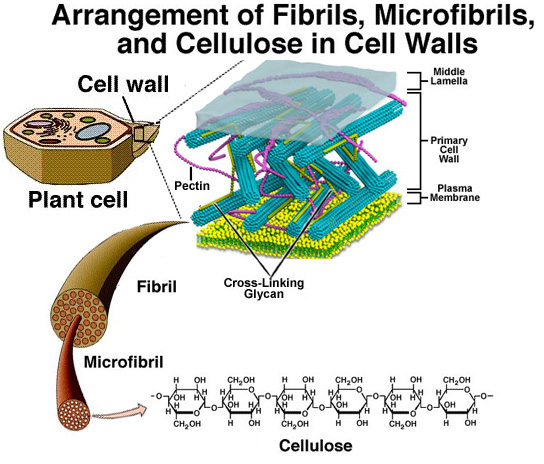

A cell wall is a more or less solid layer surrounding a cell. They are found in bacteria, archea, fungi, plants, and algae. Animals and most other protists have cell membranes without surrounding cell walls. When a cell wall is removed using cell wall degrading enzymes, what is left of the cell and its surrounding plasma membrane is called a protoplast. The cell walls main purpose is to actually protect the interior from any physical movement that may damage the cell.
Plant cell walls have a number of functions: they provide rigidity to the cell for structural and mechanical support, maintaining cell shape, the direction of cell growth and ultimately the architecture of the plant. The cell wall also prevents expansion when water enters the cell. The term turgor is used to describe this pressure that is induced by excess water inside the plant cell. Cell walls protect against pathogens and the environment and are a store of carbohydrates for the plant. The cell wall is constructed primarily from a carbohydrate polymer called cellulose.
The primary cell wall, built by the plant first, is composed of cellulose microfibrils aligned at all angles. Microfibrils are held together by hydrogen bonds to provide a high tensile strength. Cell walls of neighbouring cells are held together by a shared gelatinous membrane called the middle lamella, which contains magnesium and calcium pectates (salts of pectic acid).Cells interact though plasmodesma(ta), which are inter-connecting channels of cytoplasm that connect to the protoplasts of adjacent cells across the cell wall.
In some plants and cell types, after a maximum size or point in development has been reached, a secondary wall is constructed below the primary wall. Unlike the primary wall, the microfibrils are aligned mostly in the same direction, and with each additional layer the orientation changes slightly. Cells with secondary cell walls are rigid. Cell to cell communication is possible through pits in the secondary cell wall that allow plasmodesma to connect cells through the secondary cell walls.
The major carbohydrates making up the primary cell wall are cellulose, pectin and hemicellulose. Insoluble cellulose fibers are meshed in to a matrix called pectin and hemicelluloses; they give the plant strength and support.
Plant cells walls also incorporate a number of proteins; the most abundant include hydroxyproline-rich glycoproteins (HRGP), also called the extensins, the arabinogalactan proteins (AGP), the glycine-rich proteins (GRPs), and the proline-rich proteins (PRPs). With the exception of glycine-rich proteins, all the previously mentioned proteins are glycosylated and contain hydroxyproline (Hyp). Each class of glycoprotein is defined by a characteristic, highly repetitive protein sequence. Chimeric proteins contain two or more different domains, each with a sequence from a different class of glycoprotein. Most cell wall proteins are cross-linked to the cell wall and may have structural functions.
Secondary cell walls may contain lignin and suberin, making the walls rigid.